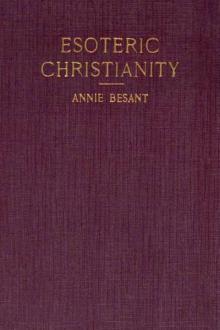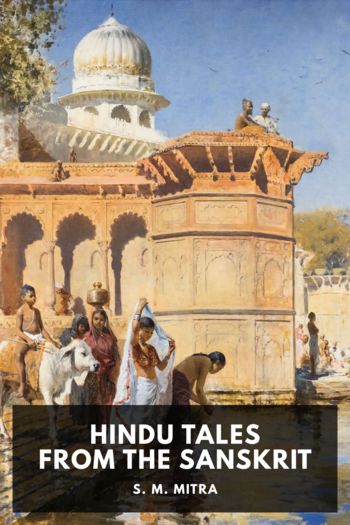Esoteric Christianity by Annie Besant (interesting books to read for teens .txt) 📕

Read free book «Esoteric Christianity by Annie Besant (interesting books to read for teens .txt) 📕» - read online or download for free at americanlibrarybooks.com
- Author: Annie Besant
- Performer: -
Read book online «Esoteric Christianity by Annie Besant (interesting books to read for teens .txt) 📕». Author - Annie Besant
These identities were thus regarded as the work of devils, copies of the Christian originals, largely circulated in the pre-Christian world with the object of prejudicing the reception of the truth when it came. There is a certain difficulty in accepting the earlier statements as copies and the later as originals, but without disputing with Justin Martyr whether the copies preceded the original or the original the copies, we may be content to accept his testimony as to the existence of these identities between the faith flourishing in the Roman empire of his time and the new religion he was engaged in defending.
Tertullian speaks equally plainly, stating the objection made in his days also to Christianity, that "the nations who are strangers to all understanding of spiritual powers, ascribe to their idols the imbuing of waters with the self-same efficacy." "So they do," he answers quite frankly, "but these cheat themselves with waters that are widowed. For washing is the channel through which they are initiated into some sacred rites of some notorious Isis or Mithra; and the Gods themselves they honour by washings.... At the Apollinarian and Eleusinian games they are baptised; and they presume that the effect of their doing that is the regeneration and the remission of the penalties due to their perjuries. Which fact, being acknowledged, we recognise here also the zeal of the devil rivalling the things of God, while we find him too practising baptism in his subjects."[177]
To solve the difficulty of these identities we must study the Mythic Christ, the Christ of the solar myths or legends, these myths being the pictorial forms in which certain profound truths were given to the world.
Now a "myth" is by no means what most people imagine it to be—a mere fanciful story erected on a basis of fact, or even altogether apart from fact. A myth is far truer than a history, for a history only gives a story of the shadows, whereas a myth gives a story of the substances that cast the shadows. As above so below; and first above and then below. There are certain great principles according to which our system is built; there are certain laws by which these principles are worked out in detail; there are certain Beings who embody the principles and whose activities are the laws; there are hosts of inferior beings who act as vehicles for these activities, as agents, as instruments; there are the Egos of men intermingled with all these, performing their share of the great kosmic drama. These multifarious workers in the invisible worlds cast their shadows on physical matter, and these shadows are "things"—the bodies, the objects, that make up the physical universe. These shadows give but a poor idea of the objects that cast them, just as what we call shadows down here give but a poor idea of the objects that cast them; they are mere outlines, with blank darkness in lieu of details, and have only length and breadth, no depth.
History is an account, very imperfect and often distorted, of the dance of these shadows in the shadow-world of physical matter. Anyone who has seen a clever Shadow-Play, and has compared what goes on behind the screen on which the shadows are cast with the movements of the shadows on the screen, may have a vivid idea of the illusory nature of the shadow-actions, and may draw therefrom several not misleading analogies.[178]
Myth is an account of the movements of those who cast the shadows; and the language in which the account is given is what is called the language of symbols. Just as here we have words which stand for things—as the word "table" is a symbol for a recognised article of a certain kind—so do symbols stand for objects on higher planes. They are a pictorial alphabet, used by all myth-writers, and each has its recognised meaning. A symbol is used to signify a certain object just as words are used down here to distinguish one thing from another, and so a knowledge of symbols is necessary for the reading of a myth. For the original tellers of great myths are ever Initiates, who are accustomed to use the symbolic language, and who, of course, use symbols in their fixed and accepted meanings.
A symbol has a chief meaning, and then various subsidiary meanings related to that chief meaning. For instance, the Sun is the symbol of the Logos; that is its chief or primary significance. But it stands also for an incarnation of the Logos, or for any of the great Messengers who represent Him for the time, as an ambassador represents his King. High Initiates who are sent on special missions to incarnate among men and live with them for a time as Rulers or Teachers, would be designated by the symbol of the Sun; for though it is not their symbol in an individual sense, it is theirs in virtue of their office.
All those who are signified by this symbol have certain characteristics, pass through certain situations, perform certain activities, during their lives on earth. The Sun is the physical shadow, or body, as it is called, of the Logos; hence its yearly course in nature reflects His activity, in the partial way in which a shadow represents the activity of the object that casts it. The Logos, "the Son of God," descending into matter, has as shadow the annual course of the Sun, and the Sun-Myth tells it. Hence, again, an incarnation of the Logos, or one of His high ambassadors, will also represent that activity, shadow-like, in His body as a man. Thus will necessarily arise identities in the life-histories of these ambassadors. In fact, the absence of such identities would at once point out that the person concerned was not a full ambassador, and that his mission was of a lower order.
The Solar Myth, then, is a story which primarily representing the activity of the Logos, or Word, in the kosmos, secondarily embodies the life of one who is an incarnation of the Logos, or is one of His ambassadors. The Hero of the myth is usually represented as a God, or Demi-God, and his life, as will be understood by what has been said above, must be outlined by the course of the Sun, as the shadow of the Logos. The part of the course lived out during the human life is that which falls between the winter solstice and the reaching of the zenith in summer. The Hero is born at the winter solstice, dies at the spring equinox, and, conquering death, rises into mid-heaven.
The following remarks are interesting in this connection, though looking at myth in a more general way, as an allegory, picturing inner truths: "Alfred de Vigny has said that legend is frequently more true than history, because legend recounts not acts which are often incomplete and abortive, but the genius itself of great men and great nations. It is pre-eminently to the Gospel that this beautiful thought is applicable, for the Gospel is not merely the narration of what has been; it is the sublime narration of what is and what always will be. Ever will the Saviour of the world be adored by the kings of intelligence, represented by the Magi; ever will He multiply the eucharistic bread, to nourish and comfort our souls; ever, when we invoke Him in the night and the tempest, will He come to us walking on the waters, ever will He stretch forth His hand and make us pass over the crests of the billows; ever will He cure our distempers and give back light to our eyes; ever will He appear to His faithful, luminous and transfigured upon Tabor, interpreting the law of Moses and moderating the zeal of Elias."[179]
We shall find that myths are very closely related to the Mysteries, for part of the Mysteries consisted in showing living pictures of the occurrences in the higher worlds that became embodied in myths. In fact in the Pseudo-Mysteries, mutilated fragments of the living pictures of the true Mysteries were represented by actors who acted out a drama, and many secondary myths are these dramas put into words.
The broad outlines of the story of the Sun-God are very clear, the eventful life of the Sun-God being spanned within the first six months of the solar year, the other six being employed in the general protecting and preserving. He is always born at the winter solstice, after the shortest day in the year, at the midnight of the 24th of December, when the sign Virgo is rising above the horizon; born as this sign is rising, he is born always of a virgin, and she remains a virgin after she has given birth to her Sun-Child, as the celestial Virgo remains unchanged and unsullied when the Sun comes forth from her in the heavens. Weak, feeble as an infant is he, born when the days are shortest and the nights are longest—we are on the north of the equatorial line—surrounded with perils in his infancy, and the reign of the darkness far longer than his in his early days. But he lives through all the threatening dangers, and the day lengthens towards the spring equinox, till the time comes for the crossing over, the crucifixion, the date varying with each year. The Sun-God is sometimes found sculptured within the circle of





Comments (0)